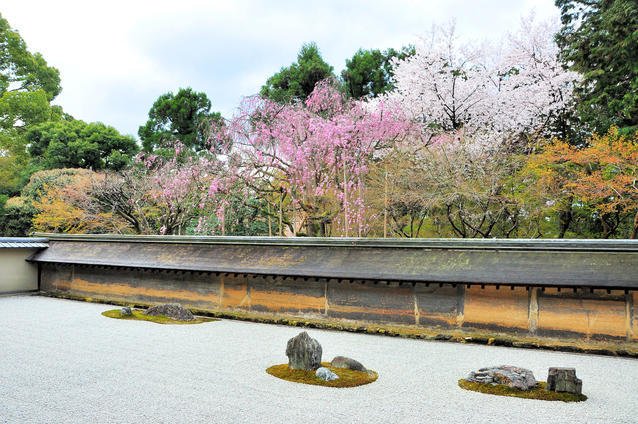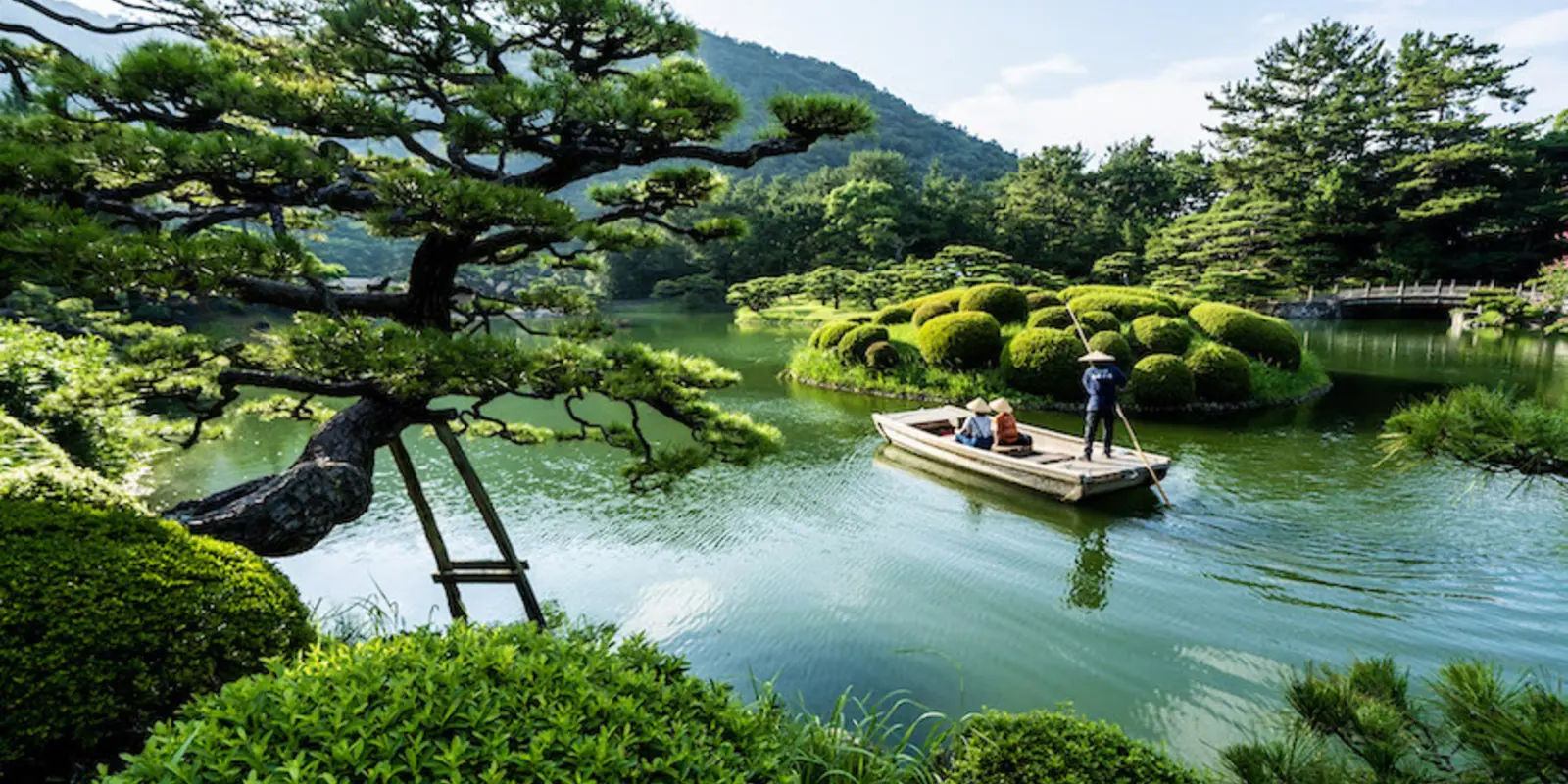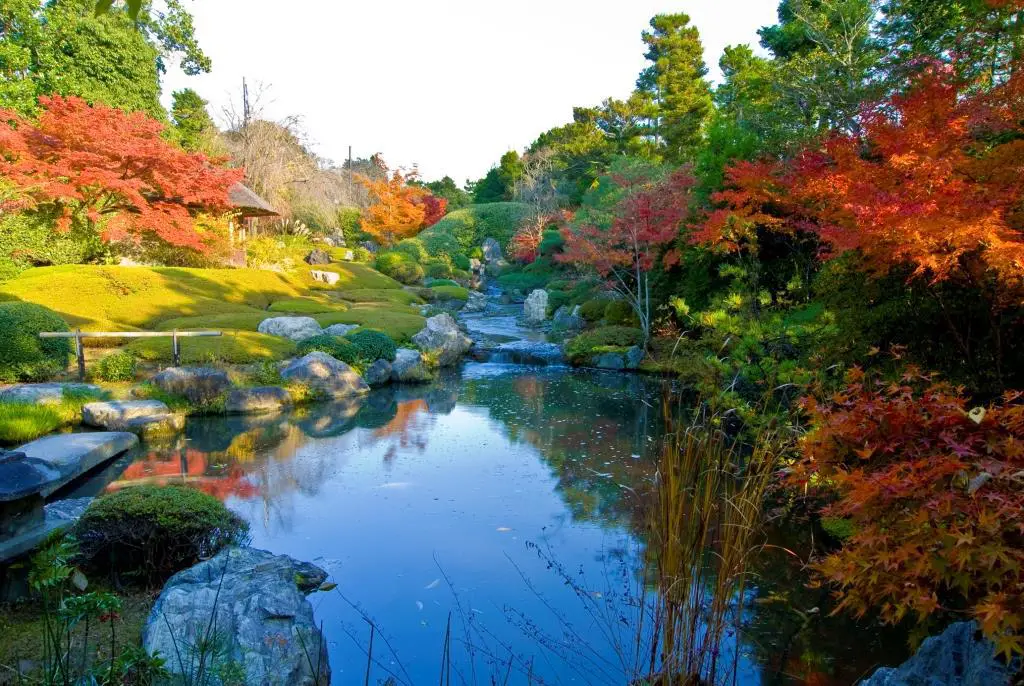Imagine stepping into a world where tranquility, beauty, and culture blend seamlessly. The Gardens of Japan Tour offers you the chance to experience this magical harmony firsthand.
Picture yourself wandering through lush landscapes, where every element is meticulously designed to evoke peace and reflection. Each garden tells its own story, inviting you to pause and immerse yourself in the rich tapestry of Japanese tradition. You will find your senses delighted by the subtle fragrances of cherry blossoms, the gentle sound of water features, and the vibrant colors of seasonal flowers.
This is not just a tour; it is an opportunity to reconnect with nature and discover a deeper sense of serenity. Get ready to uncover the secrets of these enchanting gardens and let them captivate your heart and soul.

Credit: www.michitravel.com
JUMP TO TOPIC
History Of Japanese Gardens
The history of Japanese gardens is a rich tapestry. It weaves together nature, culture, and art. Japanese gardens are more than just landscapes. They represent harmony and peace. Over the centuries, these gardens have evolved. They reflect Japan’s changing social and cultural landscapes. Each garden tells a story of the past. Let’s explore their history.
Origins And Evolution
Japanese gardens trace their origins back over a thousand years. They began during the Asuka period. Influences from China and Korea played a big role. Early gardens focused on natural beauty. They imitated natural landscapes using rocks and water. Over time, gardens evolved. Zen Buddhism shaped this evolution. The Muromachi period marked a significant change. Gardens became more abstract. They symbolized philosophical ideas.
During the Edo period, gardens flourished. They became more accessible to the public. Tea gardens, stroll gardens, and courtyard gardens emerged. Each type served different purposes. Today, Japanese gardens continue to evolve. They blend tradition with modernity.
Influence Of Buddhism And Shinto
Buddhism and Shinto deeply influenced Japanese gardens. Buddhism introduced Zen principles. These principles emphasized simplicity and meditation. Zen gardens became popular. They used rocks and gravel to represent water and mountains. Shintoism added a spiritual dimension. It revered natural elements like trees and rocks. Gardens became sacred spaces.
Shinto inspired the use of natural materials. It encouraged harmony with nature. This influence is visible in garden design. Water features, stones, and plants hold symbolic meanings. They reflect spiritual beliefs. Together, Buddhism and Shinto shaped the unique character of Japanese gardens.
Key Elements Of Japanese Gardens
Discover tranquility and beauty in Japanese gardens, renowned for their natural harmony. Experience stone arrangements, water features, and meticulously pruned plants. Delight in the serene landscapes and aesthetic precision on the Gardens of Japan Tour.
Japanese gardens are renowned for their simplicity, beauty, and deep connection with nature. These gardens are not just about visual appeal; they reflect a philosophy and a way of life. When you explore the gardens of Japan, you’ll notice several key elements that make them unique. Each element has its own story and purpose, contributing to the overall harmony and balance of the space. Let’s dive into these elements and see what makes Japanese gardens so special. ###Rocks And Sand
Rocks and sand play a fundamental role in Japanese gardens. They symbolize mountains and rivers, creating a miniature landscape. Large rocks are often strategically placed to represent islands or mountains, adding depth and dimension to the garden. Sand, often raked into patterns, represents water. This practice invites contemplation and mindfulness. Have you ever tried to rake sand into patterns? It’s surprisingly calming and allows you to focus your mind. ###Water Features
Water is a vital component in Japanese gardens, symbolizing life and renewal. Streams, ponds, and waterfalls bring a sense of movement and sound. These features create a tranquil atmosphere, inviting visitors to pause and reflect. Imagine sitting by a koi pond, watching the colorful fish glide through the water. This simple act can provide a moment of peace and clarity. Wouldn’t it be wonderful to have such a serene spot in your own backyard? ###Plant Selection
Plants in Japanese gardens are carefully chosen to highlight each season. Cherry blossoms in spring, vibrant maple leaves in autumn, and evergreen pines in winter all play their part. Each plant contributes to the garden’s changing tapestry throughout the year. Have you considered how the plants in your garden reflect the seasons? By selecting plants that bloom or change color at different times, you can create your own dynamic and evolving landscape. Why not start with a simple bonsai or a fragrant cherry blossom? Japanese gardens invite you to see the world differently. Each element has a purpose, encouraging reflection and connection with nature. As you explore these gardens, think about how you can bring some of this tranquility into your own life. What small changes can you make to create your own peaceful retreat?Iconic Japanese Gardens To Visit
Embark on a captivating journey through Japan’s iconic gardens. These serene landscapes offer a glimpse into the country’s rich history and culture. Each garden embodies unique aesthetics and philosophies. From Zen rock gardens to imperial villas, experience tranquility and beauty.
Ryoan-ji: The Zen Rock Garden
Ryoan-ji is a masterpiece of minimalist design. This Kyoto-based garden features fifteen rocks set on white pebbles. The layout encourages meditation and reflection. Visitors often seek the hidden harmony in its simplicity. It’s a must-see for those exploring Zen culture.
Kenroku-en: The Garden Of Six Sublimities
Kenroku-en is located in Kanazawa. Known for its “six sublimities,” it combines scenic beauty and spaciousness. The garden showcases ponds, streams, and teahouses. Each element represents the perfect balance of nature. It’s a delightful escape from the bustling city.
Katsura Imperial Villa
Katsura Imperial Villa is a testament to Japanese architectural elegance. It features traditional wooden structures and manicured gardens. The villa offers stunning views of Mt. Arashiyama. Experience the harmony of design and nature. Guided tours reveal its historical significance.

Credit: alljapantours.com
Cultural Significance
Japanese gardens are much more than beautiful landscapes. They hold deep cultural meanings. Each garden tells a unique story. These stories reflect Japan’s history, beliefs, and traditions. Visitors often find peace and inspiration in these spaces. The gardens reveal the soul of Japanese culture. They are living art forms.
Symbolism In Design
Japanese gardens use symbolism to convey messages. Every element holds meaning. Rocks might represent mountains. Water often symbolizes life and purity. The layout of paths suggests a journey. Plants are chosen for their symbolic value. Cherry blossoms remind us of life’s fleeting nature. Each garden element is thoughtfully placed. Together, they form a harmonious story.
Role In Japanese Traditions
Gardens play a vital role in Japanese traditions. They are settings for tea ceremonies. These ceremonies are a form of art. The gardens enhance the experience. They provide a peaceful backdrop. Festivals often occur in these gardens. People gather to celebrate and reflect. Gardens also serve as places for meditation. They offer a sanctuary from busy life. This connection to tradition is deeply ingrained. It shows the respect for nature and heritage.
Zen Philosophy And Garden Design
Japan’s gardens are more than just a feast for the eyes; they’re a journey into the depths of Zen philosophy. They offer a window into a world where design meets spiritual reflection. If you’re planning a Gardens of Japan Tour, understanding Zen principles can enrich your experience, inviting you to see beyond the beauty and into the serenity that these gardens embody.
Principles Of Simplicity And Tranquility
Japanese gardens embrace simplicity and tranquility at their core. They reflect a philosophy where less is more, guiding you to appreciate the beauty in minimalism.
Think of a garden with a few stones, some moss, and a single tree. It’s not crowded, yet it feels complete. This simplicity invites you to slow down and reflect. What in your life could benefit from this same principle?
On my last visit, I found myself drawn to a quiet corner with just a small pond and a stone lantern. The simplicity was calming, encouraging me to let go of cluttered thoughts. How often do we overlook the power of simplicity in our daily lives?
Meditative Aspects
Japanese gardens are designed to offer a meditative experience. They’re not just for show; they invite you to pause and engage with your surroundings on a deeper level.
Walking through a Zen garden is like stepping into a sanctuary for your mind. The arrangement of elements like rocks, water, and plants is intentional, encouraging mindfulness and contemplation.
During my tour, I sat by a Zen rock garden, tracing the patterns with my eyes. Each ripple in the sand felt like a gentle reminder to breathe and be present. Have you ever tried to find peace by simply observing your environment?
These gardens teach you that meditation doesn’t always require sitting cross-legged in silence. Sometimes, it’s about noticing the world around you, and finding stillness amidst it all. What part of your surroundings invites you to meditate today?
Seasonal Beauty
Japan is a land where nature’s palette paints the landscapes with breathtaking hues, especially throughout the changing seasons. The gardens of Japan are a testament to the country’s deep-rooted connection with nature and its appreciation for seasonal transformations. As you embark on a tour of these gardens, prepare to be captivated by the unique beauty that each season brings.
Cherry Blossoms In Spring
Spring in Japan is synonymous with the fleeting beauty of cherry blossoms. These delicate pink and white flowers bloom in abundance, creating a scene that feels almost magical. Imagine walking through a garden where cherry blossom petals gently fall, creating a soft, fragrant carpet beneath your feet.
During this season, gardens come alive with hanami parties, where locals and tourists gather to celebrate under the cherry trees. It’s not just the visual spectacle; it’s a cultural experience that invites you to pause and appreciate the transient beauty of life. Have you ever found yourself lost in nature’s momentary wonders?
In Kyoto’s Maruyama Park, the cherry trees are illuminated at night, offering a different perspective of their splendor. The vibrant blossoms against the night sky are an unforgettable sight. It’s a reminder that beauty can be found in every corner if you take the time to notice.
Autumn Leaves
As the air turns crisp, Japanese gardens transform into a fiery display of red, orange, and yellow leaves. Autumn in Japan is a visual feast, with gardens like Tofuku-ji Temple in Kyoto showcasing the dramatic change in foliage. The sight of maple leaves cascading down is a scene that can stir the soul.
Walking through the gardens during this time, you’ll find yourself surrounded by vibrant colors that inspire reflection and tranquility. The rustling leaves underfoot add an auditory layer to the experience, enhancing your connection to the natural world. What emotions do these colors evoke within you?
Many gardens offer special viewpoints to capture the essence of autumn. In Nikko, for instance, the Shoyoen Garden provides a perfect spot to see the reflection of fiery leaves on serene water surfaces. It’s an opportunity to engage with nature in a way that photographs can only partially capture.
Both spring and autumn in Japan offer unique opportunities to immerse yourself in the country’s natural beauty. Whether you’re marveling at cherry blossoms or gazing at autumn leaves, these gardens promise a sensory journey that leaves a lasting impression. Which season would you choose to witness first?
Gardening Techniques
Discover the enchanting beauty of Japan’s gardens through expert gardening techniques. Explore serene landscapes, traditional designs, and unique plant arrangements. Experience the harmony of nature and craftsmanship in every garden, offering insights into Japan’s rich horticultural heritage.
Embarking on a Gardens of Japan Tour offers a window into the rich tapestry of Japanese gardening techniques. These methods, refined over centuries, transform ordinary landscapes into serene sanctuaries. As you wander through these gardens, you’ll discover the careful balance of natural elements and human artistry. This harmony isn’t accidental but the result of meticulous techniques that gardeners have honed over generations.Pruning And Maintenance
Pruning is more than just trimming branches; it’s about shaping the plant’s future. Japanese gardeners approach this task with precision, ensuring each cut enhances the plant’s natural form. Regular maintenance is key, as it fosters healthy growth and prevents disease. When you prune thoughtfully, you allow sunlight to penetrate, creating a dynamic play of light and shadow. Have you ever considered how a simple snip can change your garden’s entire atmosphere? You might notice gardeners in Japan using unique tools, like special shears and saws, to achieve clean cuts. This attention to detail is what keeps the gardens looking pristine year-round. By adopting similar practices, your garden can flourish with beauty and vitality.Creating Harmony
Japanese gardens thrive on the principle of harmony. Every element, from rocks to water features, is placed with intention. This balance creates a peaceful environment that feels both natural and deliberate. In your own garden, consider how different elements interact. Are your plants complementing each other, or do they compete for attention? Japanese gardening often includes the concept of borrowed scenery, where views from outside the garden are integrated into the design. This technique expands the garden’s boundaries and connects it with the surrounding landscape. Perhaps you can draw inspiration from this approach to create seamless transitions in your outdoor space. What views can you incorporate to enhance your garden’s appeal? The Gardens of Japan Tour isn’t just a visual feast; it’s a masterclass in age-old gardening wisdom. By understanding and applying these techniques, you can transform your own garden into a harmonious retreat. Are you ready to embrace the art of Japanese gardening in your own space?
Credit: www.japan-experience.com
Planning Your Garden Tour
Planning your Garden Tour in Japan can be an exciting journey. Japan offers breathtaking gardens that showcase nature’s beauty. Each garden tells a unique story through its landscape design. Visitors can experience tranquility and elegance in every garden.
Best Times To Visit
Spring and autumn are ideal for garden tours. Spring brings cherry blossoms and vibrant flowers. Autumn offers spectacular views of colorful foliage. These seasons provide stunning backdrops for garden visits.
Summer can be hot but offers lush green gardens. Winter has fewer crowds and a serene atmosphere.
Travel Tips And Recommendations
Research the gardens you wish to visit. Each garden has its own charm and beauty. Book tickets in advance to avoid long queues. Wear comfortable shoes for walking and exploring.
Consider guided tours to learn about garden history. Carry a camera to capture beautiful moments. Respect garden rules and maintain silence.
Check local weather forecasts before planning your visit. Pack light and include essentials like water bottles. Explore nearby attractions for a complete experience.
Frequently Asked Questions
What Are The Top 3 Gardens Of Japan?
Japan’s top gardens include Kenrokuen in Kanazawa, Kairaku-en in Mito, and Koraku-en in Okayama. These gardens showcase stunning landscapes, traditional designs, and seasonal beauty. Visitors admire serene ponds, elegant bridges, and vibrant flora, making them must-see attractions for garden enthusiasts and travelers.
How Much Time Do You Need At Portland Japanese Garden?
Plan to spend 1 to 2 hours at Portland Japanese Garden. This allows time to explore and relax. Enjoy the serene landscapes, tea house, and cultural exhibits. You can extend your visit if you want a deeper experience.
What Is The Most Beautiful Zen Garden In Japan?
Ryoan-ji in Kyoto is often regarded as Japan’s most beautiful Zen garden. Known for its simplicity and tranquility, it features meticulously raked gravel and strategically placed rocks. Visitors appreciate its serene ambiance and historical significance. Ryoan-ji exemplifies Zen philosophy, making it a top attraction for those seeking peace and reflection.
What Is The Best Walking Tour Of Japan?
The Nakasendo Trail offers Japan’s best walking tour. Explore historic villages and scenic landscapes. Experience traditional culture along this ancient route. Delight in authentic cuisine and local hospitality. Perfect for nature lovers and history enthusiasts. Book a guided tour for deeper insights into Japan’s heritage.
Conclusion
Exploring Japan’s gardens offers a unique cultural experience. Each garden tells a story. The beauty of nature surrounds you. Tranquil ponds, vibrant flowers, and ancient trees captivate the senses. Visitors find peace and inspiration in these serene landscapes. Japanese gardens teach us harmony with nature.
They reflect Japan’s history and traditions. Visiting these gardens is a journey worth taking. Experience the magic yourself. Plan your trip and discover Japan’s natural wonders. Embrace the beauty and tranquility of these stunning gardens. A memorable adventure awaits in Japan’s enchanting landscapes.

